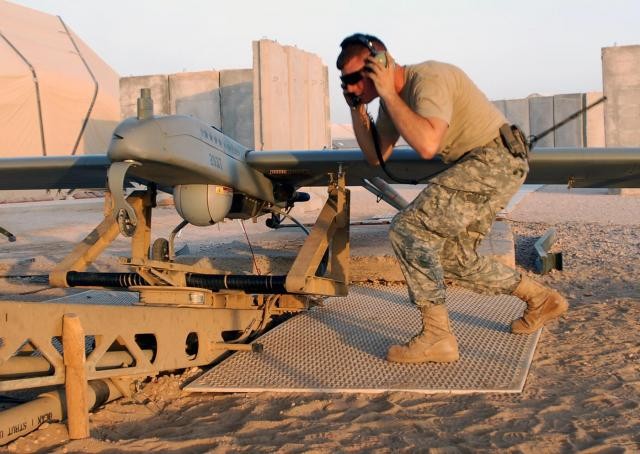
WASHINGTON (Army News Service, Sept. 27, 2010) -- The Army's Shadow unmanned aerial system was recently named the recipient of a Department of Defense award for performance-based logistics, in part for the high readiness rate of the system, its improved reliability and its decreasing cost of operation.
Announced Aug. 26, the Shadow system was awarded the Beck Award, as the system-level winner in the DoD's 2010 Performance-Based Logistics awards program.
According to the award nomination package, the government-contractor team responsible for managing and performing the Shadow PBL contract achieved exceptionally high readiness with the system, while simultaneously reducing its costs and improving its reliability.
"We are proud of the work we have done in performance-based logistics," said Tim Owings, the deputy project manager for Army unmanned aircraft systems.
Owings went on to say that Shadow flights show how readiness rates for the system have improved and how incident rates have dropped dramatically over the last several years as the program implemented performance-based logistics.
As of May 2010, the Shadow System has flown 500,000 operational hours, of which over 90-percent have been flown in combat.
"We have been able to increase the timeliness of repairing spare parts," Owings said. "By repairing more of the parts quicker, we are avoiding new buys of spare parts. All of this is being done in an environment that is driving down costs dramatically."
Instead of merely purchasing a given number of repair parts to replace aging elements of the Shadow system, a performance-based logistics approach has enabled the project manager for Army UAS to integrate logistics, engineering and reliability under a common umbrella -- thus driving down costs while increasing efficiency and readiness, explained Owings.
The Shadow's award nomination package also explains that the system's PBL team has implemented several major system modifications in the past 12 months, involving engine, battery power, communications, payload, software and human factors improvements.
"From where we sit inside the Army, PBL has given us unprecedented control over the assets we manage," Owings said. "For something changing as fast as unmanned aircraft systems -- they are very dynamic systems at a very high fielding rate -- we have been able to continually drive down costs and drive down incidents while continually spiraling in technology."
The Shadow UAS program was also praised for its readiness and availability. For instance, when U.S. Special Forces needed a tactical unmanned aerial system capability quickly -- but couldn't afford the time to train operators and technicians -- the UAS program management office and contractor responded with a government-owned, contractor-operated TUAS capability.
The GO-CO program formed two teams to operate government-owned Shadow systems, and each team deployed to Iraq in less than 90 days.
The cost savings, materiel reliability and increased operations tempo for the Shadow have been substantial as well. The program experienced a 30-percent decrease in Shadow total ownership costs from fiscal year 2008 to FY 2010. In addition, the annual cost of readiness for the Shadow systems has decreased as well.
"Just since FY 2005, we were running about $2.2 million in terms of cost of readiness -- that is the total cost that it takes for a fielded Shadow system to operate for a year," Owings said. "That number today is down in the $790,000 range. You are looking at a significant decrease in cost at a time when you have increased fielding, increased technology rotations into the systems and an increased operations tempo."
The cost avoidances are attributed to improvements in design, decreased spare parts requirements, reduced transportation costs and implementation of Lean Six Sigma methodologies.

Social Sharing